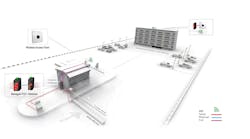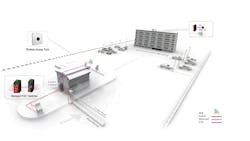Opening the Door to Access Control in Industrial Facilities
Electronic access control (EAC) systems are often installed at the doors or gates of buildings as part of an overall physical security program. EAC acts as a digital checkpoint, selectively restricting entry to a building or zone only to authorized individuals, therefore adding a critical layer of protection for the people and assets inside. The level of access a person has will vary depending on their security status, or depending on the location they are attempting to enter. EAC will also regulate the times and conditions within which access is allowed.
New Technologies, New Users
Access control once meant locked doors and photo IDs. Modern EAC is far more advanced, now boasting technologies like biometric marker identification that recognize people by their fingerprints, iris or facial features, and cloud-based systems offering off-site credentialing and monitoring, along with simplified integration with enterprise-wide, multi-site networks.
Just as EAC technology has advanced, so has its reach. Besides its traditional user base of businesses, hospitals, and schools, EAC is now deployed in industrial organizations that face growing workplace threats. These threats run the gamut from violence and theft, to vandalism and trespassing. Large manufacturing plants typically have multiple entrances, underscoring the need to control access. More doors mean greater vulnerability to security breaches.
Yet another unique risk to industrial plants is on-site heavy machinery. Imagine an unauthorized person wandering into a restricted manufacturing area without proper PPE or training. This person can be seriously injured or even killed by coming into contact with high-speed moving machinery.
Faster Response to Threats
By installing EAC, an industrial organization greatly limits these threats. EAC gives an organization a better chance to detect suspicious activity at an entrance, and empowers its security team to respond faster so that a potential breach is prevented. Another advantage of EAC is that it can track employees as they come and go from the building or within designated zones. More advanced systems will scan IDs, record visit times, and store identification information on every person who requests access to a facility. High-end systems can run an instant background check on visitors and alert security personnel to visitors who may pose a threat if they’re granted entry.
Automated Security
Access control is often referred to as a first line of defense. It is one component of a comprehensive physical security program incorporating video surveillance, alarms, parameter gates, proximity sensors, key controls, security guards, and notifications. Access control is a piece of the puzzle, but an essential piece to complete the ultimate physical security plan. Automation and networking bring it all together.
A major boon of IP-based EAC is that it can be networked, therefore enabling its automation and successful integration within the building automation system (BAS), especially when that system is cloud-based. Cloud software acts as the orchestrator while on-site network switches provide the connectivity needed between devices for automation.
Cloud-based systems support large numbers of access points and multiple sites, as no local servers or storage equipment are needed. The cloud also lets users gain visibility over access control activity of multiple manufacturing sites simultaneously from one centralized location.
Old-fashioned lock-and-key access control is costly, both in time and labor. Automated EAC eliminates the time wasted on repetitive, tedious processes typically performed manually, such as visitor logging, incident reporting, and auditing. This can reduce the number of security guards a facility needs while increasing database accuracy by doing away with human error.
Tracking Movements
During a workplace crisis, an automated EAC system will continue to track the movement of employees. Imagine a workplace hostage situation where employees are unaccounted for. Employee whereabouts can be shared in real-time with law enforcement to ensure their safety. Or what if a manufacturer suspects an employee of theft?
Automated EAC will provide an in-depth audit trail of what entry points that person is using during specific periods of time. Or let's say an industrial accident occurs. Management can go back and pull a report that matches the time frame of the incident to get a better idea of what happened, along with video of the event to share with OSHA officials.
As mentioned earlier, the cloud enables easier, faster integration of EAC with other BAS systems and for better system management. Let’s look at the example of a terminated employee. In an on-premise, non-networked system the ex-employee could mistakenly retain access for months to the building, creating a potential security risk. A cloud-based system will automatically de-provision the ex-employee's credentials.
EAC Connectivity
In a traditional access control system, there is dedicated cabling supporting communication between components. In contrast, EAC systems components are Ethernet-based with components connected to a single local or wide area network for communication, usually by a network switch permitting bi-directional communication so that devices can exchange data. This comes in handy when a software update is required, as the management system can automatically send the update to all devices on the network simultaneously.
Network connectivity also lets the management system collect data from every device on the network to permit a single view of all activity by the security staff. In addition, a PoE switch, managed or unmanaged, can supply power to connected devices making it unnecessary to plug the device into an electrical outlet.
If there is a power failure or other emergency, the devices can continue to obtain PoE power provided the network has a backup power supply. Control is simplified, as well. Security teams manage, monitor, and control the system on-site or remotely using a mobile device with a secure web browser. Traditional systems may not be compatible with remote or mobile security management solutions.
Antaira's Answer
Antaira manufacturers network switches specifically designed for harsh industrial environments. Antaira switches go beyond the performance limitations of standard devices by incorporating IP30-rated rugged aluminum cases, wide operating temperatures, redundant power, and protection from ESD, EFT, and surges.
Certain models are certified for the Class I, Div. 2 hazardous areas found in petrochemical, chemical, utilities, wastewater, and mining applications. And for those needing higher wattage PoE for power-hungry IP cameras, Antaira now offers switches supporting IEEE802.3bt for a maximum of 90 watts per port.













